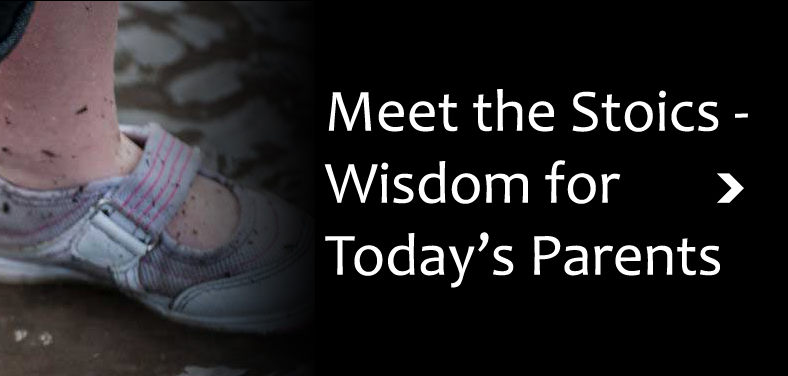A challenge with Stoicism, or any practice or belief system, is “Where do you start?”
There is the history, the basics, the “Three Ideas,” and the “One Simple Trick.” The challenge, as often is the case, is that What to do, When, and Why are all connected. So, before returning to First Things First, I am going to just jump in – with The First Law of Stoicism and setting boundaries or limits – one of the Greatest Challenges of Parenting.
When Epictetus’s pupil Arrian set to putting the great teacher’s words on paper, he presented ideas roughly in order, starting the Enchideron with these words: “There are things we can control, and things we cannot …” Much of Stoic practice is exercises designed to help the student discern what is in their control (their own thoughts & actions and responses to things) and what is not (others, acts and paths of nature, fate, etc).
The core of the Stoic “Operating System” is this: you always have a choice. You have choice over the things in your domain: decide what you do, how you think, and how you perceive things. Not only do you control those things – you are the only one who controls them: no one else can “make you feel” anything. (Implications of this fuel volumes of Stoic teaching, addressing questions like: “how do you learn to stop and recognize what is in your control – your reaction to things – and what is not?” and “How do you teach yourself to identify you emotional responses before you act on them, and are thus compromised?”)
Now, onto “Choice” with young children – and setting boundaries.
Pikkler and Gerber make much of starting the child with making their own choices at the beginning of life – for that is what free and capable individuals do – make their own choices. “Wait,” you may say “that sounds like anarchy and over-indulgence – letting the child make their own choices.”
The magic is in “Make their own choices.” The parent’s role is framing the choices for the child: the parent selects the options, the child makes the choice. This role of the parent – and powerful tool – changes very little throughout the child’s life. The secret to setting boundaries is to stage them, properly, as choices the child makes: “you can put the chainsaw down, and we’ll go for ice cream, or you can keep shredding the porch, and I’ll call the police.”
Three more relevant examples – in quick overview fashion:
Picking Shirts: The infant and the caregiver are partners in body care: they work together slowly, in a “serve-and-respond” exchange of attention and expression. The parent offers two shirts – “You have a choice – which shirt will you wear today?” and the six month old child learns that the one he points to is put on.
Higher Stakes – Choices with Eating and Introducing Boundaries
Some developmental psychologists say the first limit is set during breast feeding – if the child bites the nipple, the mother pulls her away – and the child learns not to bite.
The first meaningful choice given to most Pikkler/Gerber children is: “Sit down and eat, or get up and play.” In many ways, this “primary rule” informs lots of other ideas – and it shows both how challenging, and how rewarding and far-reaching, applying Stoic principles related to choice can be.
How it looks, how it works: The adult sits on the floor, with a plate of food the child can pick up themselves, like banana pieces. The adult says “I have some banana pieces here, if you would like to eat.” The child comes over, and the adult points to a place to sit, saying: “you may sit here, and eat some banana.” Then, the child may choose: banana is only available when sitting. Getting up and playing is an option for the child – that’s the child’s choice – but if he gets up to play, he may not eat.
The adult sets the stage. The Child leads the action. The adult has prepared the physical space, and their own mind: the adult knows what choice they will offer, and how they will deal with the child’s different possible responses. The child does not control what the choices are, but she does control her own choices, completely. (this is getting into a whole thing about health and eating … which I’ll get to in a minute).
Setting the stage is not easy, or automatic, or even intuitive. The adult has to imagine the child facing the choice – where will the child be? How will this be set up? Right away, it becomes clear that the adult must be on the floor – with the child on his lap, picnic style – so the child can easily act on her choice of “sit and eat or get up and play.” (as the child gets old, she can “graduate” to a low stool at a low table, where she can easily get up or not, as she wants to.) The child, through her capacity to choose, is the most powerful person in her own life.
So what doesn’t work? A high chair. The child is imprisoned. She still has choices – she can eat, or … throw her food. She can eat, or …. Fuss. She can stop eating when she’s had enough … and still be locked in the high chair, facing more food. High chairs are in common use, and people who were put in them came out fine. And floor feeding is better, because it supports choice, and the associated benefits. As Epictetus said, “If you want to improve, be content to be thought foolish and stupid …” (Ench. 13).
Bonus benefits to doing it right. Especially when sitting and eating are combined with other elements (“First I am going to put on your bib, then I will wipe your hands with this cloth”) creates ritual – or consistent patterns, that create comfort and confidence. When a child sits down at the same place, and the same time, and has his hands washed in the same way, and his food presented in the same way it is easier to enjoy it, and to attend to the choice he does have: sit and eat, or get up and play.
Bonus benefits of choice-based approach to eating habits: “Sit down and eat, or get up and play” supports a host of other important ideas, both related to developing an autonomous responsible child, and related to developing a healthy relationship with food. (Details may be found in Ellyn Satter’s excellent “How to Get Your Kid to Eat: But Not Too Much,” which I get into here.)
Self-regulation of eating leads to a life time of healthy eating behaviors. The Stoics would talk about respecting the “Nature” of the child. Who better knows how much food is needed, and who better to learn? A few specifics:
- Food is not emotionally currency. “Show Mommy you love her by shoving down another praline” is a fertile breeding ground for a host of pathologies.
- Parents and children learning their fundamental roles: the parent decides what food is offered, and when, and presents it. (Setting the Stage). The child eats as much as they like (free choice and self-regulation). Dad says “You may have grapes or apple slices” and the child decides how much he wants to eat.
- The parent is not a short-order cook, a galley slave, or a court chef desperate to please The Duchess. Even if a two year old could express a preference for a specific brand of Greek yogurt, it doesn’t matter: selecting the choices is not the child’s role.
- The parent offers healthy choices. When the child (almost inevitably) experiments with controlling the parent, the parent sticks to the context of choices: “You may eat what’s presented, or not.”
- The parent first focuses not on “what” is being eaten, but on “How” eating is happening – this also applies when (re)introducing family dinners.
- The child makes her own decisions, in this case whether to eat what’s offered or not, and learns from them.
- Food is not tracked all over the house, or demanded lightly. Eating is a pleasant and social ritual.
The “secret to setting boundaries” that was promised at the start of this post.
This is not a full discussion of how to set boundaries, but a simple summary of what the Stoics teach us, and how that perfectly meshes with the recommendations of today’s evidence-based mental health professionals:
“Boundaries are choices.”
Returning to the first law of Stoicism, there are things you can control, and things you cannot. You cannot control your child. You can control what choices they are offered – when you are thoughtful and you plan in advance, you can learn how to put your child in charge of choice – and all choices have consequences. When parents want to introduce or support a boundary, the first decision is what choices does the child have. Then, the boundary can be presented that way: “You have a choice …”
To the child, boundaries are facts. Present them that way. “You need to stay on this side of the line” perhaps coupled with consequences: “If you come over here, I will put you back over there.” Remember, The Voice of God is Not Tentative.
Building up the boundary muscles
The same way the Stoics counsel building up mental strength through practice, observing boundaries from early on helps children feel secure, and accept boundaries from the beginning. “You need to stay on this side of the living room/kitchen border” and “We hold hands whenever we are in a place that cars move” lead to other boundaries being accepted more easily – both by you, the boundary setting, and by the child. It’s a big topic, the Stoics can help (a lot), and you’ll hear more about it.




Add comment